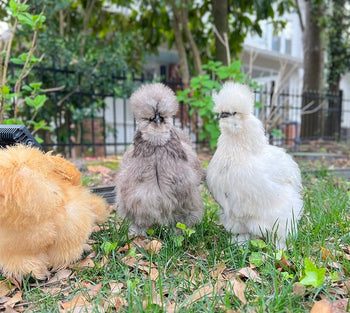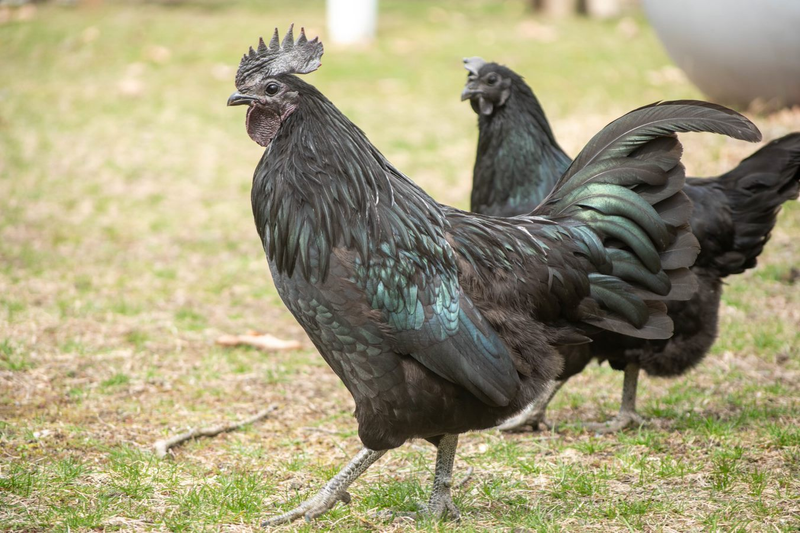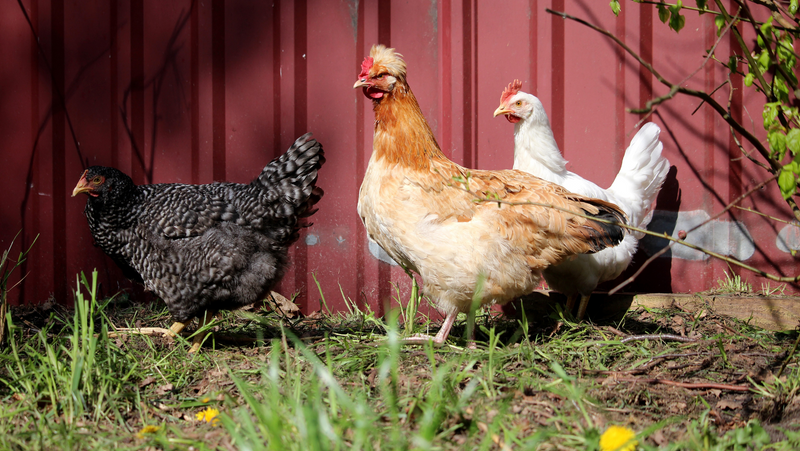Whether you are going for big and fluffy or soft and feathery, there’s a chicken breed for everyone! Extra down feathers make large birds look even fluffier, and some chicken breeds even have special feather types that make them feel satiny soft or look extra feathery. Not only are fluffy chicken breeds fun to have in your flock, but they are also often the most friendly and docile chicken breeds! Check out some of our favorite fluffy chicken breeds for your backyard flock.
#1. Silkie

How could this list begin anywhere else? Silkie chickens have some of the most unique types of feathers. Instead of having smooth and rigid feathers, Silkies are soft, fluffy, and almost fur-like. This comes from a lack of barbicels, which is what makes up the feather web of a normal chicken feather. The absence of barbicels leave Silkie feathers less rigid and fluffier.
Silkies also have crest feathers and feathered feet. In essence, their whole body is covered in feathers from head to toe. Some Silkie varieties even have muff and beard feathers on their face, which can give them the look of a fluffy teddy bear!
Silkies are technically considered a bantam breed of chicken, however, they are slightly larger than most bantam chickens. Because of their smaller size, Silkie's don’t need as much coop space and they won’t eat as much as a standard size chicken. The hens are poor egg layers and usually only produce around 100-120 eggs per year. However, the hens make excellent broody mothers and they will set on any eggs you give them! Silkies naturally have very calm temperaments and are very docile. They make great pets, are very friendly, and adapt to confinement well.
#2. Frizzle
Frizzle chickens also have a very unique feather type. Frizzles have normal feathers, except the feathers curl outward instead of lying flat against the chicken’s body. Frizzle chickens used to be considered a distinct breed by the American Poultry Association. However, now Frizzles can be any breed with the frizzle feather type, such as frizzle Polish chickens or frizzle Cochin chickens.
The offspring of two Frizzle chickens is called a frazzle or sizzle . Let’s start with Frazzles.
Frazzle chickens have extremely frizzled feathers that are often brittle. The brittle feathers are prone to breakage, often resulting in birds who are missing patches of feathers. Frazzle chickens need special care and attention in order to survive.
Sizzle chickens result from a frizzle rooster and a Silkie hen. These birds have the fur-like feathers of a Silkie chicken that curl outward like a frizzle chicken. The best of both worlds!
Since any chicken breed can be bred to have the frizzle feather type, the personality and qualities of a frizzle chicken is dependent on the breed. However, the frizzle gene is often accompanied by a friendly personality and calm demeanor.
#3. Cochin

Cochin chickens are large, fluffy birds that are well known for their fluffy feet! Cochin chickens can either be large fowl or bantam. Large fowl Cochins are especially large birds with extra fluffy down feathers and feathered shanks and feet. Bantam Cochins are just miniature versions of the large fowl Cochin, and in our expert opinions, their small size often makes them look even fluffier and cuter!
Cochin chickens are known to be very calm and friendly. They are generally docile and not very active. The hens are poor egg layers, producing only about 180-200 eggs per year, but they do make excellent mothers when they go broody.
Cochins are very cold hardy thanks to all their fluffy feathers, their feathered feet, and their small comb and wattles. The large fowl Cochins do need plenty of coop space and low roosts to accommodate their large size. Despite this, Cochins adapt well to confinement as long as they are provided with plenty of coop and enclosure space.
Another chicken breed similar to the Cochin is the Brahma. Brahma chickens are also large and heavily feathered on their bodies and shanks.
#4. Orpington

Orpingtons are another large chicken breed well known for their fluffy appearance! However, Orpingtons are such a popular chicken breed that many breeders and hatcheries are breeding for quantity over quality. Orpingtons that you get from a local hatchery or feed store will not be as fluffy as a standard bred Orpington. Standard bred Orpingtons look like one big round ball of feathers. Their shape is supposed to be rounded and curvy with no sharp angles where the neck and tail meet the body. Orpingtons are truly beautiful birds and it’s easy to see why they have raised in popularity in recent years. These chickens can be large fowl or bantam and come in many different varieties such as buff, black, blue, lavender, or white (keep in mind that some varieties of Orpingtons are not recognized as an official breed variety by the American Poultry Association). Orpingtons enjoy being around people as they are known to be docile and friendly with curious personalities.
Orpingtons are a dual-purpose breed with the hens especially good at egg laying. They can produce 3-5 large, brown eggs weekly and often lay well into the winter months. Thanks to all their feathers, Orpingtons are very cold hardy. Large fowl Orpingtons need plenty of coop space and low roosts due to their large size. Both large fowl Orpingtons and bantam Orpingtons adapt well to confinement or a free-range setting.
#5. Faverolle

The Faverolle is a fluffy and goofy looking chicken breed! They are considered a petite breed, but their truckload of feathers make them look bigger than they really are. Faverolles have feathers everywhere, even on their face, which makes them look bearded, super fluffy and soft.
Faverolle chickens are friendly, docile, and gentle. Their quiet nature makes them great for urban backyards. Faverolles are a great breed to get if you want a fluffy standard size chicken that is not super large like an Orpington or a Cochin. The hens are decent layers and will produce about 180-200 medium size eggs a year. When the hens do go broody, they make great mothers.
Faverolles are both cold hardy and heat tolerant and they adapt well to confinement or a free-range setting. One issue that can sometimes arise when raising Faverolles during the winter is when the birds drink water, the water can freeze on their beard or muff feathers. If the bird eats right after she drinks, food can also collect on the wet feathers and freeze. This can lead to other birds pulling out the Faverolle’s facial feathers in an effort to eat the food off the feathers.
This kind of bullying can be prevented by using nipple style water systems during the winter that prevent the Faverolle’s facial feathers from getting wet.
3 Tips for Caring for Fluffy Chickens
Having fluffy chickens in your backyard flock will certainly add character and uniqueness to your backyard! However, all those feathers do come with some care considerations.
1. Heat Tolerant or Cold Hardy
Fluffy chicken breeds that have unique feather types, like Silkies or Frizzles, will not be as cold tolerant and may not do well in regions that experience extreme winter weather. The nature of their fur-like or frizzled feathers does not trap heat against their body very well. On the other hand, fluffy chicken breeds that have lots of feathers, like the Cochin or the Orpington, are not as heat tolerant because all their feathers are not exactly ideal for staying cool in hot weather. When deciding what fluffy chicken breed to add to your flock, consider the seasonal weather conditions in your area.
2. Coop Accommodations
Fluffy chicken breeds also need some special chicken coop accommodations. Silkie chickens and Frizzle chickens are not very good at flying because their feathers are not like a normal chicken’s feathers that can catch air and enable them to fly. It is helpful to have low roosts and low nesting boxes in the coop to make them easier to access. Heavy, fluffy chicken breeds also benefit from low roosts and nesting boxes to prevent leg injuries and bumblefoot.
Having a dry and covered outside enclosure is very important when raising fluffy chicken breeds. Unique feather types that make a chicken fluffy are not as water resistant as normal chicken feathers. Chickens that have lots of fluffy feathers will also not dry as fast if they get wet and can become chilled. Providing your fluffy chickens with a dry, covered enclosure can allow them to get some fresh air even in inclement weather.
3. Bullying
Some fluffy chicken breeds may be prone to being bullied by other flock members if their fluffy appearance makes them stand out from the rest of the flock. Frizzle chickens and Silkie chickens are especially prone to bullying because of their unique feathers and gentle temperaments. It helps to have more than one of any fluffy chicken breed in your flock so that a single bird does not stand out from the rest because it has different feathers.

Conclusion:
Fluffy chickens are fun to hug and great for kids! Many fluffy chicken breeds are known to have calm, sweet personalities and make great pets. Adding fluffy chickens to your backyard flock can easily be done as long as you choose breeds that will adapt well to your environment and lifestyle. Want a small, fluffy chicken that will make a great pet? Get Silkie chickens! Want a fluffy chicken that will also lay plenty of eggs and be tolerant of winter weather? Look to the Orpington! As always, be a responsible chicken mother or father and look after your fluffy friends.











